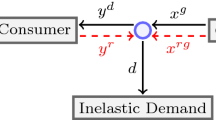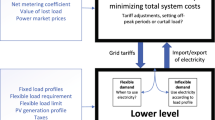Abstract
We address the Electricity Contract Selection Problem (ECSP), of finding best parameters of an electricity contract for a client based on his/her past records of electricity consumption over a fixed time period. The objective is to optimize the electricity bill composed by some fixed cost, the cost of the subscription of the electricity contract and penalties due to overpowering when consumption exceeds subscribed power. The ECSP can be formulated as a convex separable optimization problem subject to total order constraints. Due to this special structure, ECSP is a special case of two well known classes of convex separable optimization problems, namely the minimum network flow under convex separable cost and minimizing convex separable functions under chain constraints. Both classes are well treated in the litterature and can be solved in polynomial time (Ahuja and Orlin in Oper Res 49(5):784–789, 2001; Ahuja et al. in Manag Sci 49(7):950–964, 2003; Best et al. in SIAM J Optim 10:658–672, 2000; Karzanov and McCormick in SIAM J Comput 26(4):1245–1275, 1997; Minoux in Eur J Oper Res 18(3):377–387, 1984; Minoux, in Gallo and Sandi (eds) Netflow at pisa, mathematical programming studies, Springer, Berlin, 1986). In particular, the algorithm in Ahuja and Orlin (2001) achieves the best theoretical time complexity assuming that computing the objective function value at one specific point can be done in constant time. However, when we work on a big amount of historic data as in ECSP, the time required for evaluating the objective function cannot be assumed to be O(1) anymore. In this paper, we propose a new algorithm for ECSP which is specially designed to reduce the computational effort over large scale historical data. We present numerical results showing that our algorithm outperforms the algorithm in Ahuja and Orlin (2001) when applied to consumption data of various types of clients. A robust version of ECSP based on a Seasonal and Trend decomposition approach for modelling consumption uncertainty is also investigated. The resulting worst-case cost minimization problem is shown to be efficiently solvable using the same algorithm as for deterministic ECSP.


Similar content being viewed by others
References
Ahuja, R.K., Hochbaum, D.S., Orlin, J.B.: Solving the convex cost integer dual network flow problem. Manag. Sci. 49(7), 950–964 (2003)
Ahuja, R.K., Orlin, J.B.: A fast scaling algorithm for minimizing separable convex functions subject to chain constraints. Oper. Res. 49(5), 784–789 (2001)
Barbier, T.: Modélisation de la consommation électrique à partir de grandes masses de données pour la simulation des alternatives énergétiques du futur. Ph.D. thesis, Université de recherche Paris Sciences et Lettres PSL Research University (2017)
Bertsimas, D., Sim, M.: The price of robustness. Oper. Res. 52(1), 35–53 (2004)
Best, M., Chakravarti, N., Ubhaya, V.: Minimizing separable convex functions subject to simple chain constraints. SIAM J. Optim. 10, 658–672 (2000)
Chen, C.Y., Liao, C.J.: A linear programming approach to the electricity contract capacity problem. Appl. Math. Modell. 35(8), 4077–4082 (2011)
Cleveland, R.B., Cleveland, W.S., McRae, J.E., Terpenning, I.: STL: a seasonal-trend decomposition. J. Off. Stat. 6(1), 3–73 (1990)
Durand, J.B., Bozzi, L., Celeux, G., Derquenne, C.: Analyse de courbes de consommation électrique par chaines de Markov cachées. Revue de statistique appliquée 52(4), 71–91 (2003)
Hochbaum, D.S.: Complexity and algorithms for convex network optimization and other nonlinear problems. 4OR 3(3), 171–216 (2005)
Issi, F., Kaplan, O.: The determination of load profiles and power consumptions of home appliances. Energies 11(3), 607 (2018)
Karzanov, A.V., McCormick, S.T.: Polynomial methods for separable convex optimization in unimodular linear spaces with applications. SIAM J. Comput. 26(4), 1245–1275 (1997)
Kavousian, A., Rajagopal, R., Fischer, M.: Determinants of residential electricity consumption: using smart meter data to examine the effect of climate, building characteristics, appliance stock, and occupants’ behavior. Energy 55, 184–194 (2013)
Minoux, M.: A polynomial algorithm for minimum quadratic cost flow problems. Eur. J. Oper. Res. 18(3), 377–387 (1984)
Minoux, M.: Solving integer minimum cost flows with separable convex cost objective polynomially. In: Gallo, G., Sandi, C. (eds.) Netflow at Pisa, Mathematical Programming Studies, pp. 237–239. Springer, Berlin (1986)
Pipattanasomporn, M., Kuzlu, M., Rahman, S., Teklu, Y.: Load profiles of selected major household appliances and their demand response opportunities. IEEE Trans. Smart Grid 5(2), 742–750 (2014)
Rodoplu, M., Arbaoui, T., Yalaoui, A.: Energy contract optimization for the single item lot sizing problem in a flow-shop configuration and multiple energy sources. IFAC-PapersOnLine 51(11), 1089–1094 (2018)
Salerno, V., Rabbeni, G.: An extreme learning machine approach to effective energy disaggregation. Electronics 7(10), 235 (2018)
Sæle, H., Bremdal, B.A., Engan, T.T., Kristoffersen, V., Foosnæs, J.A., Nordal, T.E., Sletner, J.M.: Subscribed power-testing new power based network tariffs stimulating for demand response. In: CIRED 2015, Paper 1085 (2015)
Tatsa, S.: Modélisation et prévision de la consommation horaire d’électricité au Québec: Comparaison de méthodes de séries temporelles. Master’s thesis, Université Laval (2014)
Zemel, E.: An O(n) algorithm for the linear multiple choice knapsack problem and related problems. Inf. Process. Lett. 18(3), 123–128 (1984)
Zhou, X., Yan, D., Hong, T., Ren, X.: Data analysis and stochastic modeling of lighting energy use in large office buildings in China. Energy Build. 86, 275–287 (2015)
Acknowledgements
This work was supported by Energisme SAS in supplying data and validating the experiments.
Author information
Authors and Affiliations
Corresponding author
Additional information
Publisher's Note
Springer Nature remains neutral with regard to jurisdictional claims in published maps and institutional affiliations.
Appendix
Appendix
We state in this appendix the reformulation of \({\mathcal {P}}\) as a separable convex cost network flow problem.
The graph to be considered contains K nodes numbered \(1,2,\ldots , K\) and a set of \(2K-1\) arcs, decomposed into K ’primary arcs’ and \(K-1\) ’secondary arcs’.
-
the set of primary arcs contains the \(K-1\) arcs of the form \((i,i+1)\) for \(i=1,\ldots ,K-1\), together with a ’return arc’ (K, 1). The flow value \(x_i\) on each of these arcs (including \(x_K\) for the return arc) has to meet the bound constraints \(0\le x_i \le C\) (and \(0 \le x_K \le C\)) and the corresponding cost function is \(F_i\) (\(F_K\) for the return arc);
-
the set of secondary arcs is composed of \(K-1\) arcs of the form (1, j) for \(j=2,\ldots ,K\). The flow value \(s_j\) on each of these arcs has to meet the bound constraints \(0\le s_j \le C\), and the associated cost function is identically 0.
Problem \({\mathcal {P}}\) then reduces to determining a minimum cost circulation on the above graph. We observe that the flow values \(s_j\) on the secondary arcs play the role of slack variables for the constraints \(x_{j-1} \le x_{j}\) for \(j=2,\ldots ,K\).
Rights and permissions
About this article
Cite this article
Wu, D., Nguyen, V.H., Minoux, M. et al. Optimal deterministic and robust selection of electricity contracts. J Glob Optim 82, 993–1013 (2022). https://doi.org/10.1007/s10898-021-01032-z
Received:
Accepted:
Published:
Issue Date:
DOI: https://doi.org/10.1007/s10898-021-01032-z




